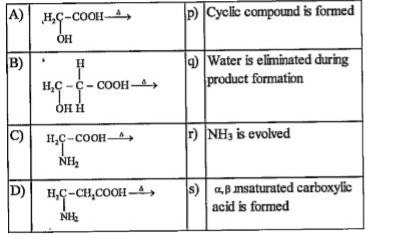Statement 1 : Peracids are stronger acids than corresponding carboxylic acids.
Statement 2 : The anion of carboxylic acids is stabilized by resonance but not that of peracids.Solution in Malayalam
Statement 1 is True, statement 2 is True, Statement 2 is Correct explanation for Statement 1.
Statement 1 is True, Statement 2 is True, Statement 2 is NOT a correct explanation for Statement 1.
Statement 1 is True, Statement 2 is False.
Statement 1 is False, Statement 2 is True.
The correct Answer is:D
Peracids are weaker acids than corresponding carboxylic acids.
Topper's Solved these Questions
- BOOK - BRILLIANT PUBLICATIONCHAPTER - CARBOXYLIC ACID & THEIR DERIVATIVESEXERCISE - LEVEL-III (Linked Comprehension Type)12videos
CARBOXYLIC ACID & THEIR DERIVATIVES
- BOOK - BRILLIANT PUBLICATIONCHAPTER - CARBOXYLIC ACID & THEIR DERIVATIVESEXERCISE - LEVEL-III (Matching Column Type)2videos
CARBOXYLIC ACID & THEIR DERIVATIVES
- BOOK - BRILLIANT PUBLICATIONCHAPTER - BIOMOLECULES, POLYMERS AND CHEMISTRY IN EVERYDAY LIFE EXERCISE - LEVEL-II (ASSERTION-REASON TYPE QUESTIONS)6videos
BIOMOLECULES, POLYMERS AND CHEMISTRY IN EVERYDAY LIFE
- BOOK - BRILLIANT PUBLICATIONCHAPTER - CARBOXYLIC ACIDSEXERCISE - LEVEL-II (Assertion -Reason)4videos
CARBOXYLIC ACIDS
Similar Questions
Paragraph
An organic compound A(C9H6O3) does not react with aqueous solution of NaHCO3 as well as does not change the colour of litmus paper. Aon acid hydrolysis gives B(C9H8O4) as major product whereas A on treatment with one equivalent of methanol in acidic medium gives C(C10H10O4) as the major product (other minor isomer of C is also formed). B on heating with sodalime gives toluene. Answer the following questions based on the above information.
The structure of A satisfying above conditions is01:57View SolutionMatch the following columns :
 11:09View Solution
11:09View SolutionAssertion : Glucose gives a reddish brown precipitate with Fehling's solution.
Reason : Reaction of glucose with Fehling's solution gives CuO and gluconic acid.08:27View SolutionAssertion : p-chlorobenzoic acid is more acidic than p-fluorobenzoic acid.
Reason : +R effect of fluorine is higher than that of chlorine due to the matching size of carbon and fluorine.01:57View SolutionAssertion: Paracids are stronger acids than corresponding carboxylic acids
Reason : The anion of carboxylic acis is stabilized by resonance but not that of paracids.01:26View SolutionExplain Why :
(i) Carboxylic acids are stronger acids than alcohols.
(ii) Carboxylic acids are stronger acids than phenols
(iii) ∝-chloropropionic acid is a stronger acid than β-chloropropionic acid.05:09View SolutionWhy is carboxylic acid a stronger acid than phenol ?
02:22View SolutionAssertion: Peracids are stronger acids than corresponding carboxylic acids
Reason : The anion of carboxylic acids is stabilized by resonance but not that of peracids.01:57View Solutionयद्पि फिनॉक्साइड आयन की अनुनादी संरचानए कार्बोक्सिलेट आयन की तुलना में अधिक है परन्तु कार्बोक्स्लीक अम्ल फिनोल की अपेक्षा प्रबल अम्ल है । क्यों ?
06:20View Solutionकथन : ऐल्कोहॉल्स कार्बोक्सिलिक अम्लों की अपेक्षा दुर्बल अम्लीय होते हैं।
कारण : ऐल्कॉक्साइड आयन अनुनाद द्वारा स्थायित्व प्राप्त करता है।04:25View SolutionAlthough phenoxide ion has more number of resonating structures than carboxylate ions carboxylic acid is a stronger acid than phenol. Why ?
View SolutionStatement 1: Peracides are stronger acids than corresponding carboxylic acids. Statement 2: The anion of carboxylic acids is stabilized by resonance but not that of peracids.
04:01View Solutionकार्बोक्सिलिक अम्ल, ऐल्कोहॉलों की तुलना मे प्रबल अम्ल होते हैं, क्यों?
View SolutionAlthough phenoxide ion has more number of resonating structures than carboxylate ion, carboxylic acid is a stronger acid than phenol. Why?
11:11View SolutionAlthough phenoxide ion has more number of resonating structures than carboxylate ion, carboxylic acid is a stronger acid than phenol? Why?
View SolutionStatement 1: Parasit is a more potent acid than compatible carboxylic acids. Statement 2: The anions of carboxylic acids are stable by resonance but not of paracetamol.
View Solution

